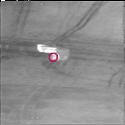
|
Detection and Target Tracking In FLIR Imagery |
Targets in closing FLIR imagery generally appear as bright "hot-spots" having high contrast than their neighboring regions. We first perform region-based segmentation to detect targets where regions corresponds to possible the targets. Target candidates are then determined by considering: brightness, gradient information on the boundary of the region and the contrast with the neighboring regions. Among the detected candidates, the false positives are extracted by utilizing the texture information of the candidate and its neighboring regions. We experimented the following texture measures: GLCM, Law¹s Texture Energy, Measures, Wavelets and Steerable Pyramids
Our experiments demonstrated that by using Steerable Pyramids as texture measures along with the Energy as the feature vector and the Median as the distance measure we were able to eliminate the most (94%) of the false positives among the detected target candidates.
Associated publications:
Target-Tracking
in FLIR Imagery Using Mean-Shift and Global Motion Compensation
Workshop on Computer Vision Beyond the Visible Spectrum, with CVPR 2001,
Kauai, Hawaii, Dec 14, 2001
Target-Tracking
in Airborne Forward Looking Infrared Imagery
Image and Vision Computing Journal, in press, 2003
For Power Point presentation
click here
Result Videos:
Sequence
1
Sequence
2
Sequence
3
Sequence
4
Sequence
5
Sequence
6
Sequence
7
Sequence
8
Sequence
9
Sequence
10